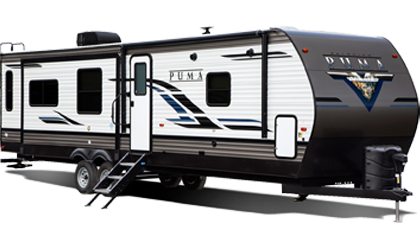RV Weather Safety

Camping is the ultimate family activity. You get to spend time connecting with each other and grounding yourselves in nature away from the distractions of everyday life. But, in an average year in the United States, there are 10,000 thunderstorms, 5,000 floods, 1,000 tornadoes and six named hurricanes.
With this many storms, it’s bound to happen that you’ll get caught in one of them. How do you know when to call it quits and head for the hills or when to ride it out? These are some tips from pro-RVers to keep you and your family safe on your next RV excursion.
Lightning
On average, 310 people are struck by lightning each year. Storms that bring lightning don’t always bring rain with them as well. Thunder is the best indicator of when a lightning storm will hit. When you hear that thunder roll, pull in your slides and awnings, and pack up anything that’s not anchored down to the ground to prevent it from being blown around. Seek shelter indoors during a lightning storm is indoors. Inside a building is best, but inside your vehicle is the next best option.
Flash Flooding
Water is great on a hot day when you’re enjoying it at the lake, but underestimating its power in a storm can have deadly consequences. You should never try to cross areas that are more than ankle deep, as they can have sharp debris or toxic wildlife swept along with their current. Even though it doesn’t seem like much, at a fast-moving rate, it can knock you off balance and send you downstream with it. In the case of vehicles, as little as two feet of moving water can have devastating effects and carry your vehicle with it. Think you’re safer in a larger vehicle? Take a look at this video.
When preparing for flash flooding, it’s best to be aware of local watches and warnings. Listen to the radio, check the national weather websitesor download an app to give you the latest severe weather updates. Head to high ground as soon as you know there’s a flash flood watch or warning in effect to keep you and your passengers safe.
Hurricanes and Tornadoes
Over 90% of the United States is susceptible to tornadoes and hurricanes. With this kind of statistic, it’s likely you’ll experience at least one watch or warning for these storms. Under these circumstances, being proactive is your best line of defense. Tornadoes are unpredictable and can appear with little to no warning. When you get to your campground, you should ask where the nearest storm shelter is, especially if you’re traveling in areas that are especially prone to tornadic activity. It’s best to be in an interior room on the ground level of a concrete building when taking shelter, but sometimes public shelters are unavailable. In these situations, some have said that parking under a bridge or overpass can shield you from debris, but because of wind dynamics, debris tends to funnel through these locations and be even more dangerous. If you’re traveling down the road and don’t have access to a building, find the lowest lying ground you can, fasten your seatbelt and keep your head covered below your window line.
Hurricanes that make landfall usually allow warning for those in its path because they build strength over the ocean before making their way to the coast. This warning should be enough time for you to pack up and head further inland away from danger. Hurricanes tend to lose strength over land, so the further inland you are, the less dangerous the storm will be. Make no mistake, this doesn’t mean weakening systems aren’t dangerous, just that they’re less so than when they first hit. If you don’t have enough time to pack up camp, ask where the local shelter is and head there before the storm makes its way to you. Never attempt to ride out a hurricane in an RV, but do make sure all of your tanks are full before you begin evacuation. There’s nothing worse than trying to evacuate and finding yourself caught in the storm.
In short, your safety and that of those around you is ultimately up to you. Whether you decide get to shelter before things really get hairy or wait until the last possible moment, you affect the safety of those traveling with you and the rescue workers that potentially have to help you out of a sticky situation. Use common sense when traveling in hazardous weather prone areas and stay safe while you’re out enjoying your Good Life.















